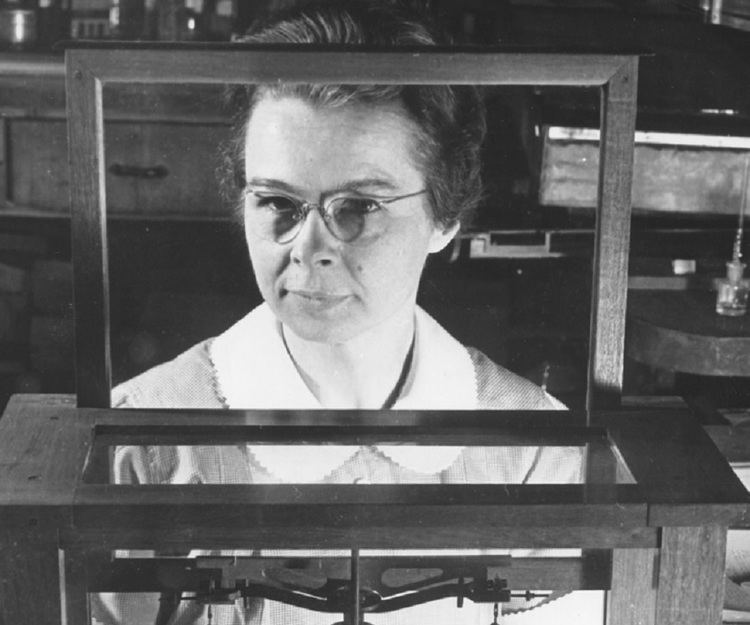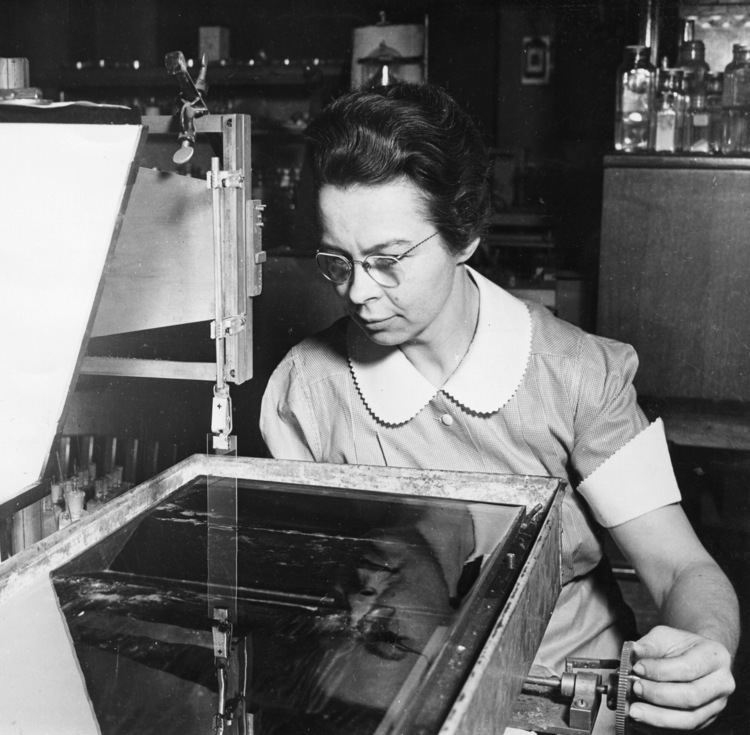Occupation inventor, physicist Name Katharine Blodgett | Role Physics researcher | |
 | ||
Parent(s) Katharine BurrGeorge Blodgett Died October 12, 1979, Schenectady, New York, United States | ||
Katharine Burr Blodgett (January 10, 1898 – October 12, 1979) was an American scientific researcher. She was the first woman to be awarded a Ph.D. in physics from the University of Cambridge, in 1926. After receiving her master's degree, she was hired by General Electric, where she invented low-reflectance "invisible" glass.
Contents

Birth and childhood
Blodgett was born on January 10, 1898 in Schenectady, New York. She was the second child of Katharine Burr and George Blodgett. Her father was a patent attorney at General Electric where he headed that department. He was shot and killed in his home by a burglar just before she was born. GE offered a $5,000 reward for the arrest and conviction of the killer, but the suspected killer hanged himself in his jail cell in Salem, New York. Her mother was financially secure after her husband's death, and she moved to New York City with Katharine and her son George Jr. shortly after Katharine's birth. In 1901 the family moved to France.
In 1912, Blodgett returned to New York City with her family where she was enrolled in the Rayson School.
Work at General Electric
Blodgett was hired by General Electric as a research scientist as soon as she had received her master's degree. She was the first woman to work as a scientist for General Electric Laboratory in Schenectady, NY. She often worked with Langmuir, who had pioneered a technique for creating single-molecule thin films on the surface of water. Blodgett and Langmuir explored the application of similar techniques to lipids, polymers, and proteins, creating monomolecular coatings designed to cover surfaces of water, metal, or glass. These special coatings were oily and could be deposited in layers only a few nanometers thick.
In 1935, Blodgett extended Langmuir's work by devising a method to spread monomolecular coatings one at a time onto glass or metal. By repeatedly dipping a metal plate into water covered by a layer of oil, she was able to stack oil layers onto the plate with molecular precision. The apparatus which she used and refined is known as the Langmuir–Blodgett trough.
Using this technique, Blodgett developed practical uses for Langmuir’s gossamer films. Blodgett used a barium stearate film to cover glass with 44 monomolecular layers, making the glass more than 99% transmissive and creating "invisible" glass. The visible light reflected by the layers of film canceled the reflections created by the glass. This type of nonreflective coating is now called Langmuir-Blodgett film and is widely used. The first major cinematic production to use Blodgett's invisible glass was the popular film Gone with the Wind (1939), noted for its crystal-clear cinematography. Once introduced, nonreflective lenses were used for projectors and cameras by the post-war movie industry. Blodgett's glass was also used for submarine periscopes and airplane spy cameras during World War II.
Blodgett also invented the color gauge, a method to measure the molecular coatings on the glass to one millionth of an inch. The gauge employs the concept that different thicknesses of coatings are different colors. While examining the layering of stearic acid on a glass plate, she realized that the addition of each layer, about 2/10,000,000 inch thick, reliably changed the color of the plate. Before her invention, the best measurement instruments were only accurate to a few thousandths of an inch. Her glass "ruler" much more precisely showed the progression of colors and their corresponding thicknesses. Measuring thickness became as simple as matching colors.
Blodgett and Langmuir also worked on improvements to the light bulb. Their studies on electrical discharges in gases helped lay the foundations for plasma physics.
Dr. Blodgett was issued eight U.S. patents during her career. She was the sole inventor on all but two of the patents, working with Vincent J. Schaefer as co-inventor. Blodgett published over 30 technical papers in various scientific journals and was the inventor of poison gas adsorbents, methods for deicing aircraft wings, and improving smokescreens.
Personal life
Blodgett never married and lived a vibrant life, living in a Boston marriage for many years with Gertrude Brown, who came from an old Schenectady family. For another period she also lived with Elsie Errington, the English-born director of a nearby girls' school. "The household arrangement freed Blodgett from most domestic responsibilities—except for making her famous applesauce and popovers." Unfortunately, she did not leave any personal papers with her thoughts about her long-term relationships with these women.
Blodgett's niece and namesake was astrophysicist and civil servant Katharine Blodgett Gebbie. In an autobiographical memoir, Gebbie recalled that on family visits her Aunt Blodgett:
"always arrived with suitcases full of 'apparatus', with which she showed us such wonders as how to make colors by dipping glass rods into thin films of oil floating on water."Gebbie often spoke in later life of her aunt's influence by personal example on her choice of a career in science.
Social life and hobbies
Blodgett bought a home in Schenectady overlooking her birthplace where she spent most of her adult life. She was an actress in her town's theater group and volunteered for civic and charitable organizations. Blodgett was the treasurer of the Traveler's Aid Society there. She spent summers at a camp at Lake George in upstate New York, to pursue her love of gardening. Blodgett was also an avid amateur astronomer; she collected antiques, played bridge with friends and wrote funny poems in her spare time. She died in her home on October 12, 1979.
Awards
Blodgett received numerous awards during her lifetime. In 1945, she received the Achievement Award from the American Association of University Women. In 1951 she received the prestigious Francis Garvan Medal from the American Chemical Society for her work on monomolecular films. That same year, she was chosen by the U.S. Chamber of Commerce as one of 15 "women of achievement.” Among many other awards she had received, the mayor of Schenectady honored her with Katharine Blodgett Day on June 13, 1951 because of all the honor she had brought to her community. In 2007 she was inducted into the National Inventors Hall of Fame. In 2008 an elementary school in Schenectady was opened bearing her name.
